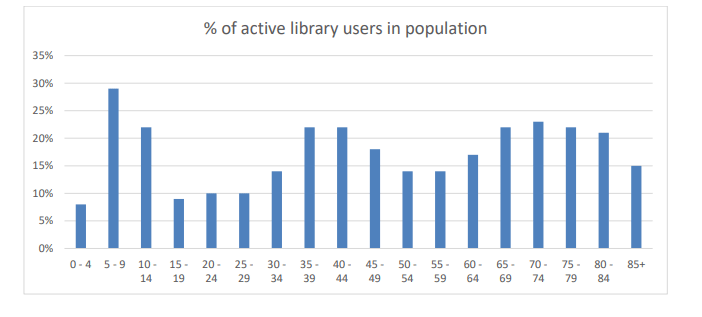Library strategy - Users
Age
For full data please see appendix A.
As shown in Chart 11 , about the borough’s increasing older population, over 20% of retired residents already use Richmond library services, though that percentage drops in the 85+ age group – probably due to issues with access and health.
29% of the 5-9 age group regularly use library services and 22% of 10 -14 age group but only 8% of the under 4 years have been brought to library buildings in the last two years (a drop of 2%). Library services are less frequently used by the 15 -29 age group than other groups and young people are a group towards whom services are deliberately targeted.
These are ‘active library users’ rather than ‘active library borrowers’ as per the CIPFA standard (defined as those borrowing physical books only). In modern times and during the coronavirus pandemic especially, it has become vital to include people using eServices when looking at people benefitting from library services. Unfortunately, CIPFA have not yet changed their data collection to include this.

Ethnicity
With regard to ethnicity, 87% of PLUS respondents regarded themselves as White British or from a White background, with 13% from other ethnic groups. The ethnicity of library PLUS respondents is very similar to the ethnic makeup of the borough found in the borough profile, as shown below in Table 12.
|
Ethnicity |
PLUS |
Borough |
|---|---|---|
| White British | 71 | 71.4 |
| Irish | 3 | 2.6 |
| Other White | 14 | 11.9 |
| White and Black Caribbean | 1 | 0.7 |
| White and Black African | 1 | 0.4 |
| White and Asian | 1 | 1.5 |
| Mixed ethnic background | 1 | 1 |
| Indian | 2 | 2.8 |
| Pakistani | 1 | 0.6 |
| Bangladeshi | 0 | 0.5 |
| Chinese | 2 | 0.9 |
| Other Asian background | 2 | 2.5 |
| African | 1 | 0.9 |
| Caribbean | 0 | 0.4 |
| Any other Black/African | 0 | 0.2 |
| Arab | 0 | 0.6 |
| Any other group | 1 | 1 |
Gender
The current Richmond Library Services active membership figure is 35,088 with 62% female users and 38% male users. The borough profile is 51.4% female and 48.6% male3 so library service use tends to be higher in females. This may also reflect the fact that carers are more likely to be female and therefore bring children or dependents to the library.
Footnotes
- Data from Spydus LMS and DataRich Population Explorer
- Borough data from DataRich
- Data from Spydus LMS and DataRich Population Explorer
Updated: 19 February 2024
 Stay up to date! Make sure you subscribe to our email updates.
Stay up to date! Make sure you subscribe to our email updates.
